二硫纶修饰的β-环糊精的自包合以及对金属离子的响应
焦华晶 王琪 丁刘镠 芦昌盛*,
二硫纶修饰的β-环糊精的自包合以及对金属离子的响应
焦华晶1王琪2丁刘镠1芦昌盛*,1
(1南京大学化学化工学院配位化学国家重点实验室,南京210093)
(2江苏省特种设备安全监督检验研究院,南京211178)
利用圆二色光谱,核磁,等温滴定量热法和化学滴定方法研究单-6-马来二氰二硫代酸钠-β-环糊精在水溶液中的自包合性质。化学滴定实验结果表明十二烷基硫酸钠(SDS),Cu2+和Co2+可以改变单-6-马来二氰二硫代酸钠-β-环糊精的构象,并且得出单-6-马来二氰二硫代酸钠-β-环糊精在水溶液中的存在形式是自包合的结论;Cu2+可以作为打开单-6-马来二氰二硫代酸钠-β-环糊精自包合结构的“钥匙”,使其构象改变后可以与中性红(NR)发生包合作用;加入EDTA与Cu2+配位后,单-6-马来二氰二硫代酸钠-β-环糊精恢复自包合结构,同时释放中性红客体分子。
单-6-马来二氰二硫代酸钠-β-环糊精;圆二色;自包合;金刚烷胺
Cyclodextrins are cyclic oligosaccharides widely used as artificial hosts for various guest-molecules. The guest-molecules included in the cyclodextrins cavities usually exhibit chemical and physical properties quite different from those of their un-included forms in the bulk aqueous environment.Therefore,great achievements have been witnessed with cyclodextrins in many of the most actively pursued research fields,such as drug delivery system, molecular sensor,bio-mimetic recognition,and catalysis[1-2].
In order to enhance the molecular recognition and inclusion affinity of cyclodextrins to their specific guests,more and more functional groups have been chemically recruited into these natural hosts.It is much interesting that some monotonous cyclodextrins derivatives exhibit self-included complexation intramolecularly or intermolecularly,which results in the dimerization or polymerization of these hosts molecules[3-5].The self-assemblies and aggregates of these functionalized cyclodextrins plus their probable responses to external photonic/electrical/chemical stimuli could make them one of the most potential candidates for mimicking bio-relevant systems of interests,such as photochromically-contractible or electrochemically-driven molecular machines,and redox-driven or light-driven molecular muscles[6].
In this paper,we report the self-included complexation intramolecularly of maleonitriledithiolate -modifiedβ-cyclodextrin host(6-mnt-β-cyclodextrin, scheme 1)and its conformational response to metal ions.Due to its self-inclusion,6-mnt-β-cyclodextrin shows guest-specificity when including different guest molecules.For example,it exhibits inclusion complexation with 1-adamantanamine hydrochloride(Ada) (which has a strong binding affinity with cyclodextrin cavity),but not with neutral red(NR).In addition,the presence ofmetalions is able to tune the selectivity of the host.Upon metal coordination,6-mnt-β-cyclodextrin self-inclusion can be disrupted reversibly to include NR,and liberate the guest molecule again when removing the key metal ion.

Scheme 1 Illustration of 6-mnt-β-cyclodextrin host
1 Experimental
UV spectra were recorded on a Shimadzu UV-3100 spectrometer.Induced circular dichroism(ICD) measurements were performed on a JASCO J-810 circular dichroism spectrometer.1H and13C NMR spectra were recorded on a Bruker AVANCE-500 spectrometer in deuterium-oxide(D2O)at 15℃. Fluorescence spectra were recorded on a Perkin Elmer LS55 spectrometer.Isothermal titration calorimetry (ITC)experiments were performed on a GE Healthcare MicroCal ITC200.
β-Cyclodextrin was purchased from Seebio Biotechnology Inc.(P.R.China),and 6-mnt-β-cyclodextrin was prepared according to reference[6].Sodium dodecyl sulfate(SDS)was obtained from Sigma-Aldrich(USA) and used as received.Ada and NR were purchased from J&K Scientific Ltd.,and used as received.
2 Results and discussion
6-Mnt-β-cyclodextrin was synthesized previously by modifying parentβ-cyclodextrin with 2-butenedinitrile-2,3-dimercapto disodium salt(Na2mnt)[7].The ionized host showed three absorption bands(around 251,350 and 399 nm)in ICD spectra but only two (around 272 and 369 nm)in UV spectra(curve 1 in Fig.1a).These bands were recorded before,but not correctly elucidated[8].
2.1 Intramolecular self-included complexation of 6-mnt-β-cyclodextrin
Ithas been reported that the sign and intensity of the ICD signals depend on the orientation of the guest molecule with respect to the major axis(C7 axis)of cyclodextrin[9-11].The orientation and thereby the geometry of the CD complexes are deduced using a set of rules originally derived for ICD of chiral supramolecular systems which are initially derived for CD complexes and later generalized for complexes of chiral macrocycles[12-13].We have the following rules:(1)The sign of ICD is positive for a transition polarized parallel to the axis of the macrocyclic host, and negative for that polarized perpendicular to the axis.(2)The sign of ICD is reversed when a chromophore moves from the inside of the host cavity to the outside,while keeping the direction of the transition moment unchanged.(3)The absolute value of ICD is greater when a chromophore exists on the outside of the narrower rim than when it is on the outside of the wider rim[14-16].
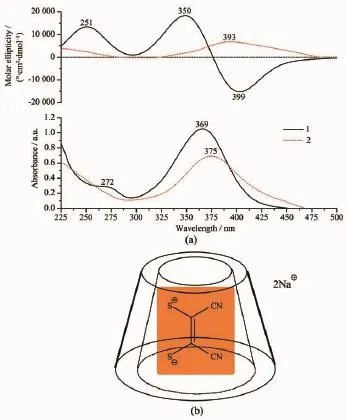
Fig.1(a)CD(above)and UV(below)spectra of 6-mnt-βcyclodextrin(0.1 mmol·L-1,curve 1,solid),and Na2mnt(0.1 mmol·L-1,curve 2,dot)in the presence ofβ-cyclodextrin(6.0 mmol·L-1)in water at 298 K;(b)Proposed structure of inclusion complex Na2mnt@β-cyclodextrin
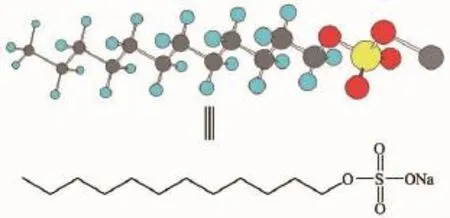
Scheme 2 Illustration of SDS
Amphiphiles,for instance SDS(scheme 2),can strongly dissociate the aggregation of cyclodextrins derivatives[17].So,the titration experiments of SDS into 6-mnt-β-cyclodextrin solution were performed to figure out whether the mnt group is in the hydrophobic cyclodextrin cavity.
The CD peak at around 350 nm changes steppingly along with the CD trough at around 399 nm,upon increasing concentration of SDS(as shown in Fig.2a).Evidently,the sign of CD is reversed when in much molar excess.In the meantime,there are merely minor changes on the UV curves(Fig.2a).And the effectof SDS is leveled offwhen the concentration of SDS exceeds 300 folds of the host(data not shown). Therefore,the addition of SDS does not trigger any chemicalreactions of the mnt chromophore in solution (based on the UV spectra),but(when in much molarexcess)effectively disrupts the original configuration of 6-mnt-β-cyclodextrin.So the mnt group in the hydrophobic cyclodextrin cavity is suggested according to rule(2).1H-NOESY spectrum of this mixture suggests the inclusion of SDS into 6-mnt-βcyclodextrin cavity(Fig.S1).
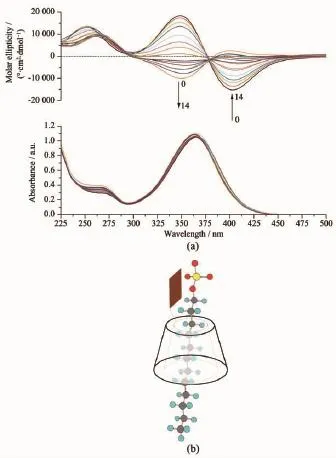
Fig.2(a)CD(above)and UV(below)spectra of 6-mnt-βcyclodextrin(0.1 mmol·L-1)in water at 298 K in the presence of increasing concentrations of SDS (CSDS=0,0.04,0.08,0.12,0.2,0.32,0.4,0.6,0.8, 1.0,1.2,1.6,2.0,2.4,115 mmol·L-1for curves 0 to 14);(b)Proposed structure of 6-mnt-β-cyclodextrin in the presence of SDS(Brown parallelogram represents un-included mnt chromophore)
At the meantime,the probable pattern of 6-mntβ-cyclodextrin is highly suggested and proposed in Scheme 3,where mnt group was in the hydrophobic cyclodextrin cavity.Generally,the HH-type(primaryface-to-primary-face)dimers are thermodynamically more favorable than HT-type(primary-face-to-secondary -face),as they are stabilized by reciprocal inclusion of the pendant groups into cyclodextrin cavities[18].And the HT-type dimerization of cyclodextrins hosts is ready to produce various host-aggregates and hostpolymers.
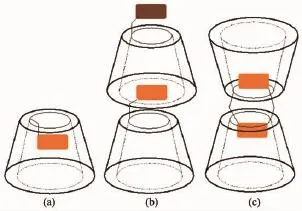
Scheme 3 Proposed self-inclusion pattern(a),HT-type (b)and HH-type mutual-encapsulation(c)of 6-mnt-β-cyclodextrin in aqueous solution (Orange rectangles demonstrate included mnt chromophores,while the brown one represents un-included mnt chromophore)
The mnt chromophore shows the ability to bind naturalβ-cyclodextrin with pretty high affinity(Kinclusionis calculated to be 3×103L·mol-1as indicated in our previous study[19]).Therefore,ifthe configuration of the 6-mnt-β-cyclodextrin is the HH-type or the HT-type there should be dependence of ellipticity on the concentration of naturalβ-cyclodextrin into 6-mnt-βcyclodextrin solution in CD spectra[20].Actually under our experimental conditions,no dependence of ellipticity is found on the concentration of naturalβcyclodextrin into 6-mnt-β-cyclodextrin solution in CD spectra(Fig.3),suggesting an intramolecular selfincluded complexation of 6-mnt-β-cyclodextrin.The sign of ICD as the concentration of 6-mnt-β-cyclodextrin increases linearly(Fig.4)suggesting the selfinclusion of6-mnt-β-cyclodextrin again.
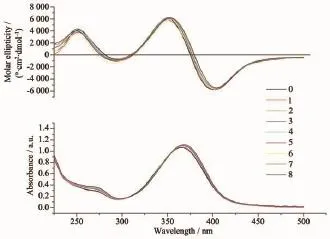
Fig.3 CD spectra of 6-mnt-β-cyclodextrin(50μmol·L-1) in water at 298 K in the presence of increasing concentrations ofβ-cyclodextrin.Cβ-cyclodextrin=0,0.01, 0.10,0.25,0.50,0.75,1.00,1.50,2.00 mmol·L-1for curves 0 to 8
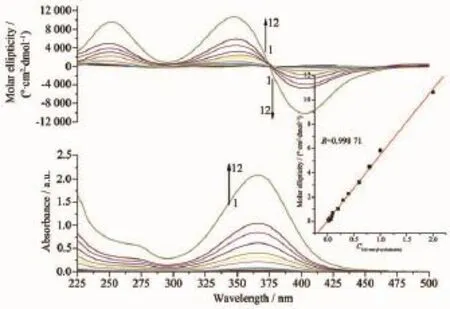
Fig.4 CD(above)and UV(below)spectra of increasing concentrations of 6-mnt-β-cyclodextrin in water at 298 K,(C6-mnt-β-cyclodextrin=0.002,0.004,0.006,0.008, 0.01,0.02,0.03,0.04,0.06,0.08,0.1,0.2 mmol· L-1for curves 1 to 12);Inset shows the plot of the concentration-normalized CD intensity at 347 nm against C6-mnt-β-cyclodextrin;Red solid line is the fitted curve
At the meantime,the illustration of self-inclusion of 6-mnt-β-cyclodextrin is suggested in Scheme 4.As a result of the limitation of spatial geometry,the mnt group and the axis of the cyclodextrin host have a slope angle.According to the configuration of 6-mnt-β-cyclodextrin,the transition polarized is divided into two components,parallelto the axis ofthe cyclodextrin host(L∥)and perpendicular to the axis(L⊥).So the ICD of 6-mnt-β-cyclodextrin is consistent with rule(1).

Scheme 4 Illustration of self-inclusion of 6-mnt-β-cyclodextrin
In order to investigate the self-inclusion of 6-mnt-β-cyclodextrin,guest inclusion experiments were performed.Ada is a good candidate for host-guest inclusion complexation withβ-cyclodextrin,because of its suitable size and a strong binding constant of 1.8× 104L·mol-1[21].As shown in Fig.5a,the presence of excessive Ada does not alter the CD spectroscopy of 6-mnt-β-cyclodextrin but increases the magnitude.

Scheme 5 Illustration of Ada
1H NOESY spectrum of this mixture suggests the inclusion of Ada into 6-mnt-β-cyclodextrin cavity(Fig. S2).In addition,ITC measurements were carried out as well to quantitively give a Kbindingof(1.78±0.04)×104L·mol-1(Fig.S3).Under the same experimental conditions,the Kbindingof Ada withβ-cyclodextrin at pH value of 4.92 is(6.22±0.40)×103L·mol-1(Fig.S4).The results confirm that Ada has better access(under our experimental conditions)to 6-mnt-β-cyclodextrin cavity than it does in the case of inclusion complex Ada@β-cyclodextrin[21].However,Ada titration could not disrupt the self-inclusion of 6-mnt-β-cyclodextrin in solution,even with a high inclusion affinity to the host cavity.According to literature[22]the CD spectral patterns of 6-mnt-β-cyclo-dextrin are almost similar to the spectra without guests,except for an increase in intensity,which indicates no change in the environment around the mnt chromophores and suggests that the mnt chromo-phores entity still is inside the cavity of the cyclo-dextrin.So the structure of inclusion complex Ada@6-mnt-β-cyclodextrin is proposed(Fig. 5b).Because the mnt group is small,it could be inside the cyclodextrin cavity.Ifthe hostpolymerization of 6-mnt-β-cyclodextrin takes place and dominates in aqueous solution,both ends of 6-mnt-β-cyclodextrin must be blocked by sequential-penetration or intermo-lecular self-inclusion complexation.In this case,the molecular cavities of the hosts will be inaccessible to Ada guests.However,it is still possible for Ada to bind with 6-mnt-β-cyclodextrin as long as the Kbindingis higher than that of host aggregation.The inclusion of Ada into 6-mnt-β-cyclodextrin cavity could completely dissociate the host polymerization to bring about dramatic changes in CD spectra.In fact,no such disruptive changes of ICD signals are recorded(Fig. 5a).Therefore,the polymerization of 6-mnt-β-cyclodextrin via sequential-penetration could be suppressed since the molecular cavity of 6-mnt-β-cyclodextrin is accessible to Ada.
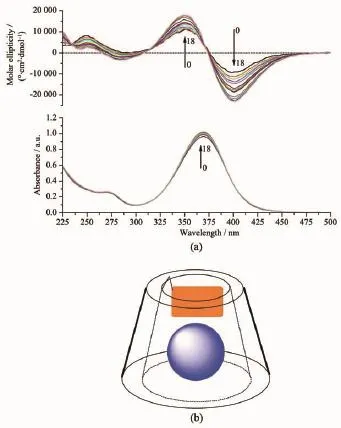
Fig.5(a)CD(above)and UV(below)spectra of 6-mnt-βcyclodextrin(1×10-4mol·L-1)in water at 298 K in the presence of increasing concentrations of Ada (CAda=0,0.01,0.02,0.03,0.04,0.05,0.06,0.07, 0.08,0.09,0.10,0.20,0.30,0.40,0.50,0.60, 0.70,0.80,0.90 mmol·L-1for curves 0 to 18);(b) Proposed structure of inclusion complex Ada@6-mnt-β-cyclodextrin with a 1∶1 stoichiometry
Based on our assumption of 6-mnt-β-cyclodextrin self-inclusion in aqueous solution,the best fitting of SDS experiments(subjected to a self-inclusion model) is reasonable and accounts for the above-mentioned Ada competitive titration results.
2.2 Titration of 6-mnt-β-cyclodextrin with metal -ions
Generally,metal ions help to associate cyclodextrins derivatives with each other to form complicated aggregates,especially when metal-chelating reagents are recruited as functional groups on the rims of cyclodextrins.Since 6-mnt-β-cyclodextrin host is embedded with a dithiolate group as potential ligand, metal-ions titration experiments were then performed to investigate the competitive metal-binding interaction with the above-mentioned hostself-inclusion.
It is amazing that the self-inclusion of 6-mnt-βcyclodextrin could be disrupted by metal ions.As shown in Fig.6a,the host self-inclusion is very sensitive to copperion(up to the concentration levelof10-6mol·L-1).When titrated with increasing concentrations of CuCl2,6-mnt-β-cyclodextrin displays bathochromic-shift from 369 to 406 nm in UV spectra(curve 18 in Fig.6a).The splitting CD couplet at around 376 nm(in the region 290~590 nm)is completely transformed into three positive and one negative bands, which mountains at around 296,371,448,and 332 nm,respectively.CD spectroscopy is a very sensitive tool to directly reflect the configuration of guestmolecules inside hosts′cavities[23].Therefore our data highly suggest that the self-inclusion 6-mnt-βcyclodextrin is disrupted/unlocked by Cu2+ion via competitive metal-coordination.In addition,the stoichiometry of Cu2+to 6-mnt-β-cyclodextrin is 1∶3 based on the accumulative changes of ellipticity in Fig.6a at different wavelengths(Fig.S5).Given the steric hindrance ofcyclodextrins cavities,the probable structure of Cu·(6-mnt-β-cyclodextrin)3is demonstrated in Fig.6b.So,the copper-coordinating complexation seemed to be superior during the competition of hostself-inclusion versus metal-coordination.
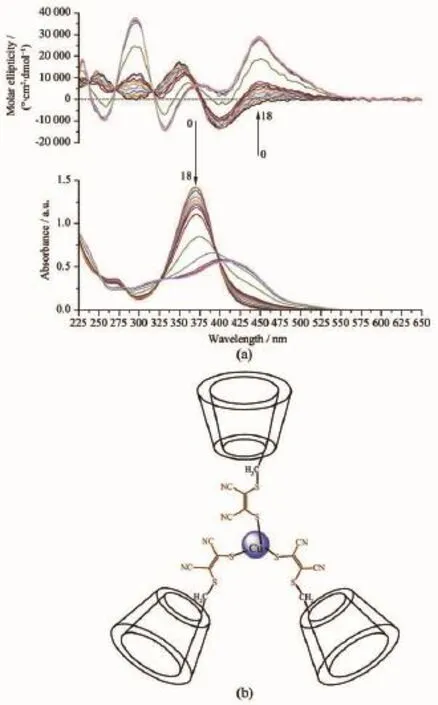
Fig.6(a)CD(above)and UV(below)spectra of 6-mnt-βcyclodextrin(1×10-4mol·L-1)in water at 298 K in the presence of increasing concentrations of CuCl2; (C CuCl2=0,1,2,3,4,5,6,7,8,9,10,20,30,40, 50,60,70,80,90μmol·L-1for curves 0 to 18); (b)Proposed structure of complex Cu·[6-mnt-βcyclodextrin]3
The addition of CoCl2(with a concentration higher than 3×10-2mol·L-1)into 6-mnt-β-cyclodextrin solutioncould bring about almost the same disruption of host aggregation(Fig.S6),while other cations failed such as Mn2+,Ni2+and Zn2+.It seems that the mnt group is completely buried in the cavity of 6-mnt-βcyclodextrin since no coordination interactions either in UV or in CD spectra are observed in the cases of MnCl2,NiCl2,and ZnCl2(Fig.S7)[24].So,the proposed self-inclusion 6-mnt-β-cyclodextrin host shows metalion selectivity during the coordination complexation and subsequentconformational changes in solution.
2.3 Controllable encapsulation of 6-mnt-βcyclodextrin with Neutral Red upon copper ion coordination
Since 6-mnt-β-cyclodextrin exhibits self-inclusion and controllable dissociation upon preferred metalions coordination in solution,it is much interesting to apply this aggregation-dissociation behavior to guests inclusion complexation.As 6-mnt-β-cyclodextrin shows pretty strong signals in both UV and CD spectra but zero in fluorescence,fluorescent guests seems to be good candidates.
NR(scheme 6)is a well-known candidate used for detecting host-guest interactions in supramolecular chemistry[25],which gives fluorescent emission at around 626 nm in weak basic solution(curve 1 in Fig. 7).Upon addition with 10-fold 6-mnt-β-cyclodextrin, NR shows minor changes either in the maximum emission wavelength or in the peak intensity(curve 2 in Fig.7).It is much different from reported data,in which NR is observed to exhibit evident hypsochromic shift and fluorescence intensity enhancement when in inclusion complexation withβ-cyclodextrin[26].Therefore,the self-inclusion of 6-mnt-β-cyclodextrin is competing with the guest inclusion complexation here, and thus does not produce inclusion complex of NR@6-mnt-β-cyclodextrin in solution as usual.In addition,our data show that the presence of 8-fold Na2mnt in solution is able to effectively quench the fluorescence of NR by 60%(Fig.S8).However,no quenching of NR is recorded even in the presence of 10-fold 6-mnt-β-cyclodextrin.So,the present data strongly support our above assumption that the mnt chromophore is deeply buried in the host cavity and inaccessible to the competitive NR guest(NR shows a binding constant of 480 L·mol-1with naturalβcyclodextrin[26]).

Scheme 6 Illustration of NR
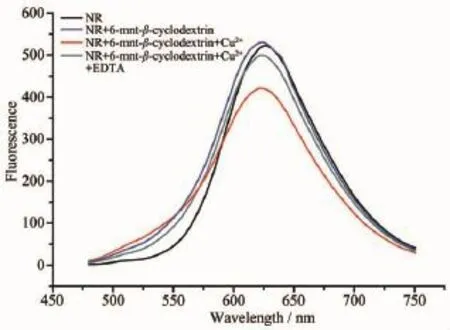
Fig.7 Fluorescence spectra(λex=453 nm)of NR(1×10-5mol·L-1)in buffer(pH=8.5)at 298 K in the presence of 6-mnt-β-cyclodextrin,([6-mnt-βcyclodextrin]=1×10-4mol·L-1;CCu2+=1×10-4mol· L-1;CEDTA=2×10-4mol·L-1)
If Cu2+really functions as a key to unlock the self-inclused host as proposed above,the fluorescence quenching of NR in the presence of 6-mnt-β-cyclodextrin plus Cu2+should be experimentally recorded. As a matter offact,the fluorescence intensity of NR is decreased by 20%when Cu2+is added into the sample (Fig.7).This quenching does not result from Cu2+,as proved by our experimental data(Fig.S9).Therefore,it seems that the addition of Cu2+into 6-mnt-β-cyclodextrin does change the self-inclusion-locked conformation of the host,and the“open”host could thus be accessible to NR to effectively quench the fluorescence of the guest-molecule by pendant mnt chromophore.
In order to verify the key function of metal ion during the unlocking process,Cu2+is then removed by chelating complexation with EDTA[27](ethylene diamine tetraacetic acid).As shown in Fig.7,removal of metal ion from the mixture recovers the fluorescence of NR.At the meantime,the extraction of Cu2+by EDTA restores the characteristic CD couplet of the host as shown in the free 6-mnt-β-cyclodextrin(Fig.8).It indicates that the unlocked host is re-locked and regained the self-inclusion conformation.In another word,the locked-unlocked conformational equilibrium could be reversibly switched by Cu2+ion.

Fig.8 CD(above)and UV(below)spectra of 6-mnt-βcyclodextrin(1×10-4mol·L-1)in buffer at 298 K (pH=8.5,CCu2+=1×10-4mol·L-1and CEDTA=2×10-4mol·L-1)
3 Conclusions
The mnt chromophore shows the ability to bind naturalβ-cyclodextrin with pretty high affinity(Kinclusionis 3×103L·mol-1)as proved in our previous study[18]. Therefore,it is reasonable to suggest that 6-mnt-βcyclodextrin tends to self-inclusion in solution according to the reported literatures.Actually under our experimental conditions,no dependence of ellipticity on the concentration of naturalβ-cyclodextrin into 6-mnt-β-cyclodextrin solution in CD spectra is recorded (Fig.3),suggesting a self-inclusion ofthe host.
In summary,the maleonitriledithiolate-modified β-cyclodextrin exhibits self-inclusion in aqueous solution.When in its self-inclusion conformation,6-mnt-βcyclodextrin is“closed”and shows more stringent guest-selectivity.However,the“closed”status could be reversibly tuned to“open”by chemical-stimulus, for example by addition of Cu2+ion.In its unlocked conformation,6-mnt-β-cyclodextrin shows relaxed guest -selectivity and is able to include NR guest.Taking into consideration the switchable“close”and“open” conformations of the host,6-mnt-β-cyclodextrin has shown the potential to controllably include and release guest-molecule with conformational response to copper ion.Therefore,6-mnt-β-cyclodextrin could be a good candidate in the future for chemical sensor,drug delivery,and molecular machinery studies.
The supporting information is available at http://www. wjhxxb.cn
Acknowledgements:This work was supported by the National Basic Research Program of China(2010CB923402), National Nature Science Foundation of China(No.91122031), Jiangsu Science&Technology Department(BK2011550)and Center of Modern Analysis,Nanjing University.We also thank Miss Guo Qiaochu from Nanjing Foreign Language School for the ITC measurements and calculations.
[1]D′Souza V T,Lipkowitz K B.Chem.Rev.,1998,5:1741-1742
[2]Yuan D Q,Lu J Z,Atsumi M,et al.Chem.Commun.,2002: 730-731
[3](a)Ma X,Wang Q C,Tian H.Tetrahedron Lett.,2007,48:7112 -7116
(b)Zhong C,Mu T,Wang L,et al.Chem.Commun.,2009: 4091-4093
(c)Liu Y,Shi J,Guo D S.J.Org.Chem.,2007,72:8227-8234
(d)Liu Y,Zhao Y L,Zhang H Y,etal.J.Phys.Chem.B,2004, 108:8836-8843
(e)Ueno A,Ikeda A,Ikeda H,et al.J.Org.Chem.,1999,64: 382-387
(f)Nielson M B,Nielson S B,Becker J.Chem.Commun., 1998:475-476
[4](a)Gao X M,Tong L H,Zhang Y L.Tetrahedron Lett.,1999, 40:969-972
(b)Gao X M,Zhang Y L,Tong L H,et al.J.Incl.Phenom. Macrocycl.Chem.,2001,39:77-80
(c)Fujimoto T,Sakata Y,Kaneda T.Chem.Commun.,2000: 2143-2144
[5]Liu Y,Wang H,Chen Y,et al.J.Am.Chem.Soc.,2005,127: 657-666
[6](a)Park J W,Choi N H,Kim J H.J.Phys.Chem.,1996,100: 769-774
(b)Mirzoian A,Kaifer A E.Chem.Commun.,1999:1603-1604
(c)Liu Y,Yang Z X,Chen Y.J.Org.Chem.,2008,73:5298-5304
(d)Balzani V,Gómez-López M,Stoddart J F.Acc.Chem.Res., 1998,31:405-414
(e)Sauvage J P.Acc.Chem.Res.,1998,31:611-619
(f)Jimenez-Molero M C,Dietrich-Buchecker C,Sauvage J P. Chem.Eur.J.,2002,8:1456-1466
(g)Liu Y,Flood A H,Bonvallet P A,etal.J.Am.Chem.Soc., 2005,127:9745-9759
(h)Dawson R E,Lincoln S F,Easton C J.Chem.Commun., 2008:3980-3982
(i)Kuad P,Miyawaki A,Takashima Y,et al.J.Am.Chem. Soc.,2007,129:12630-12631
[7](a)Lu C S,Zhang W W,Ren X M,et al.Dalton Trans.,2001: 3052-3055
(b)Lu C S,Ren X M,Hu C J,etal.Chem.Pharm.Bull.,2001, 49:818-821
[8]Lu C S,Lu Z D.J.Incl.Phenom.Macrocycl.Chem.,2007, 59:357-361
[9]Harata K,Uedaira H.Bull.Chem.Soc.Jpn.,1975,48:375-378
[10]Shimizu H,Kaito A,Hatano M.Bull.Chem.Soc.Jpn.,1979, 52:2678-2684
[11]Shimizu H,Kaito A,Hatano M.Bull.Chem.Soc.Jpn.,1981, 54:513-519
[12]Kodaka M.J.Phys.Chem.,1991,95:2110-2112
[13]Kodaka M.J.Am.Chem.Soc.,1993,115:3702-3705
[14]Park J W,Lee S Y,Song H J,et al.J.Org.Chem.,2005,70: 9505-9513
[15]Pagliari S,Corradini R,Galaverna G,et al.Chem.Eur.J., 2004,10:2749-2758
[16]Zhang X,Nau W M.Angew.Chem.,Int.Ed.,2000,39:544-547
[17]Park J W,Song H E,Lee S Y.J.Phys.Chem.B,2002,106: 5177-5183
[18]González-Álvarez M J,Balbuena P,Mellet C O,et al.J. Phys.Chem.B,2008,112:13717-13729
[19]Lu Z D,Lu C S,Meng Q J.J.Incl.Phenom.Macrocycl. Chem.,2008,61:101-106
[20]Song L X,Wang H M,Guo X Q,et al.J.Org.Chem.,2008, 73:8305-8316
[21]Jobe D J,Verrall R E,Juquera E,et al.J.Phys.Chem., 1993,97:1243-1248
[22]Francois D,Patrice W,Marc Bria,et al.Carbohydr.Res., 2005,340:1706-1713
[23](a)Bakirci H,Zhang X,Nau W M.J.Org.Chem.,2005,70: 39-46
(b)Dsouza R N,Nau W M.J.Org.Chem.,2008,73:5305-5310
[24]Cheng X,Wang Q,Lu C S,et al.J.Phys.Chem.A,2010, 114:7230-7240
[25](a)Liu Y,Li C J,Guo D S,et al.Supramol.Chem.,2007,19: 517-523
(b)Shaikh M,Choudhury S D,Mohanty J,et al.Phys.Chem. Chem.Phys.,2010,12:7050-7055
(c)Zhang G M,Shuang S M,Dong Z M,et al.Anal.Chim. Acta,2002,474:189-195
(d)Shaikh M,Mohanty J,Bhasikuttan A C,et al.Chem. Commun.,2008:3681-3683
[26](a)Singh M K,Pal H,Koti A S R,et al.J.Phys.Chem.A, 2004,108:1465-1474
(b)Liu Y,Song Y,Chen Y,et al.J.Phys.Chem.B,2005, 109:10717-10726
[27]Le X S,Shu Z P,Lin H Z,et al.Inorg.Chem.,2011,50: 2215-2223
Maleonitriledithiolate Modifiedβ-Cyclodextrin:Self-Inclusion and Response to Metal Ions
JIAO Hua-Jing1WANG Qi2DING Liu-Liu1LU Chang-Sheng*,1
(1State Key Laboratory of Coordination Chemistry,Nanjing National Laboratory of Microstructures, School of Chemistry and Chemical Engineering,Nanjing University,Nanjing 210093,China)
(2Jiangsu Province Special Equipment Safety Supervision Institute(JSSEI),Nanjing 211178,China)
The self-inclusion ofmaleonitriledithiolate-modifiedβ-cyclodextrin(mono[6-deoxy-6-(2-butene-dinitrile-2,3-dimercapto)]-β-cyclodextrin,6-mnt-β-cyclodextrin)was studied by circular dichroism(CD)spectroscopy,1H NMR spectroscopy,isothermal titration calorimetry(ITC),and chemical titration methods.Chemical titration results indicate that sodium dodecyl sulfate(SDS)is able to effectively dissociate the configuration of 6-mnt-βcyclodextrin,as well as Cu2+and Co2+do in solution.The experimental data suggest that 6-mnt-β-cyclodextrin prefers self-inclusion in aqueous solution,which could be reversibly unlocked by metal ions.In its unlocked conformation,6-mnt-β-cyclodextrin is able to include Neutral Red(NR)and exhibits host-guestinteractions.Upon removal ofthe“key”metalion,6-mnt-β-cyclodextrin liberates the guestmolecule and restores its self-inclusion. Therefore,the maleonitriledithiolate-modified cyclodextrin host exhibits potential to controllably uptake and release its guest by selected metalion coordination.
mono[6-deoxy-6-(2-butenedinitrile-2,3-dimercapto)]-β-cyclodextrin;circular dichroism;self-inclusion;Ada
O614.121;O614.81+2;O641.3
A
1001-4861(2015)07-1269-09
10.11862/CJIC.2015.180
2015-04-03。收修改稿日期:2015-05-11。
江苏省自然科学基金(No.BK2011550)资助项目。
*通讯联系人。E-mail:luchsh@nju.edu.cn;会员登记号:S060014696M。

